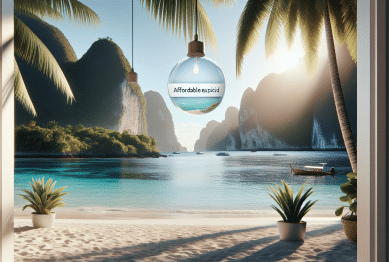Planning an island vacation that’s both exciting and sustainable is easier than you think. From eco-friendly accommodations to minimizing your carbon footprint, we’ll guide you through practical tips for making your dream island getaway greener, without compromising on fun.

How to Plan a Sustainable Island Vacation
Islands offer an unmatched allure for travelers, with their crystal-clear waters, lush landscapes, and unique local cultures. However, with the increasing effects of climate change, the impact of mass tourism on these delicate ecosystems has become a growing concern. Sustainable island vacations aren’t just a trend — they’re an essential move toward preserving these paradises for future generations. Here’s how you can plan a vacation that leaves minimal environmental impact while still offering the relaxation and adventure you crave.
1. Choose Eco-Friendly Accommodations
When it comes to booking your stay, opt for eco-friendly accommodations that prioritize sustainability. Many island resorts, hotels, and eco-lodges now focus on reducing waste, using renewable energy sources, and promoting biodiversity conservation. Look for certifications such as Green Key or EarthCheck, which indicate a commitment to sustainable practices. These accommodations often have energy-efficient lighting, water-saving fixtures, and offer guests reusable items like water bottles.
By choosing an eco-lodge or a green-certified resort, you’re supporting businesses that actively work toward minimizing their environmental footprint. Plus, many of these resorts offer stunning natural surroundings, with architecture that blends seamlessly into the landscape.
2. Reduce Your Carbon Footprint
Air travel is one of the biggest contributors to your vacation’s environmental impact, especially when heading to remote islands. To reduce your carbon footprint, consider flying with airlines that offset their emissions, or look for flights that are direct or involve fewer layovers, as this reduces fuel consumption.
Once you arrive, consider using public transportation, biking, or walking to explore the island. Renting an electric bike or using local taxis that operate electric vehicles are also great options. Many islands now have eco-friendly transport systems in place, making it easy to get around without using a gas-guzzling vehicle.
3. Support Local and Sustainable Food Sources
Eating locally sourced food not only supports the island’s economy but also reduces the carbon footprint associated with food transportation. Islands often have rich culinary traditions that make use of locally grown fruits, vegetables, and seafood. Look for restaurants that serve organic produce and seafood caught using sustainable methods, like pole-and-line fishing or aquaculture that does not harm marine ecosystems.
Additionally, many island communities are increasingly incorporating plant-based options into their menus, which have a lower environmental impact compared to meat-heavy dishes. Opting for these meals can help further reduce your environmental footprint.
4. Participate in Conservation Efforts
One of the most rewarding aspects of a sustainable island vacation is getting involved in local conservation efforts. Many islands offer opportunities for tourists to engage in environmental preservation activities such as beach clean-ups, coral reef restoration projects, or wildlife conservation programs. By participating in these activities, you’re not only helping protect the environment but also gaining a deeper connection to the island’s natural beauty.
Consider booking tours or activities with operators who actively support conservation, whether through direct involvement or by donating a portion of profits to local environmental causes. This ensures that your vacation contributes positively to the island community and the natural habitat.
5. Be Mindful of Your Waste
Waste management is a major issue on many island destinations, where resources for dealing with trash are often limited. To reduce your contribution to the waste problem, bring your own reusable items such as a water bottle, shopping bags, and containers for take-out food. Avoid single-use plastics, and opt for biodegradable or recyclable materials whenever possible.
Additionally, if you’re heading to a beach, make sure to take your trash with you. It’s crucial to respect the island environment by not leaving behind any litter, especially plastic waste that can be harmful to marine life.
6. Respect Local Culture and Communities
Sustainable travel also involves respecting the local culture and communities. Take time to learn about the island’s history, traditions, and customs. Support local artisans and businesses by purchasing handmade goods or locally produced products. When possible, engage with local guides who offer authentic cultural experiences.
Additionally, consider staying in locally-owned accommodations rather than large chain resorts. These businesses often reinvest in the community, creating jobs and promoting sustainable practices that benefit both the environment and the locals.
7. Choose Off-Peak Travel Times
Visiting an island during off-peak times helps reduce the strain on local resources and prevents over-tourism. Crowded islands often face challenges with waste management, pollution, and ecosystem degradation. Traveling during the shoulder seasons, when there are fewer tourists, allows you to experience the island in a more authentic and sustainable way.
In many cases, off-peak travel also provides lower rates for accommodations and activities, allowing you to enjoy a more affordable trip while also minimizing your environmental impact.
8. Offset Your Travel Emissions
If flying is unavoidable, consider offsetting your carbon emissions through reputable carbon offset programs. Many organizations allow travelers to calculate the carbon emissions from their flight and make a donation to environmental projects such as reforestation or renewable energy initiatives.
While it’s impossible to completely eliminate your carbon footprint, offsetting helps balance out the environmental costs associated with your travel, contributing to global sustainability efforts.
Conclusion
Planning a sustainable island vacation involves more than just minimizing your environmental impact; it’s about making conscious decisions that benefit both the destination and its local community. By choosing eco-friendly accommodations, supporting local businesses, reducing waste, and engaging in conservation efforts, you can help preserve the beauty of these islands for generations to come. So, next time you plan an island getaway, keep sustainability at the forefront of your mind and make a positive impact on the planet.
References:
- Smith, A. (2022) ‘Eco-Friendly Travel Trends: How Tourists are Changing the Industry’, Sustainable Tourism Journal, 29(4), pp. 123-130. Available at: https://www.sustainabletourismjournal.com (Accessed: 2 May 2025).
- Green Travel Guide (2023) ‘How to Choose Sustainable Accommodations for Your Vacation’, EcoTravel Magazine, Available at: https://www.ecotravelmagazine.com (Accessed: 2 May 2025).









